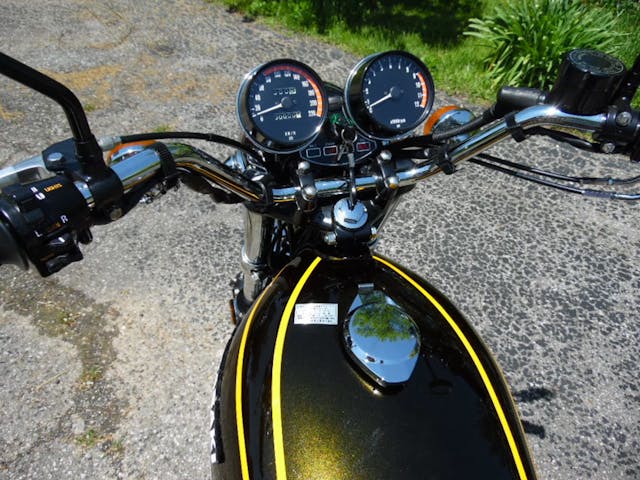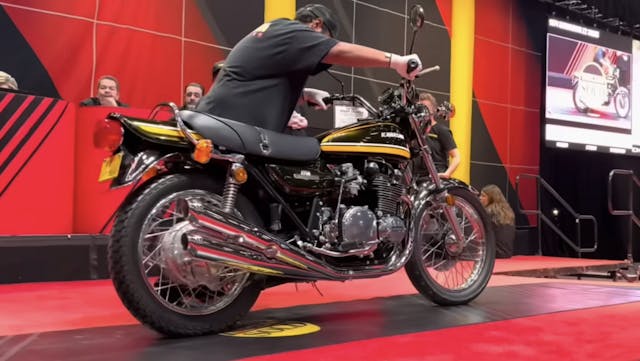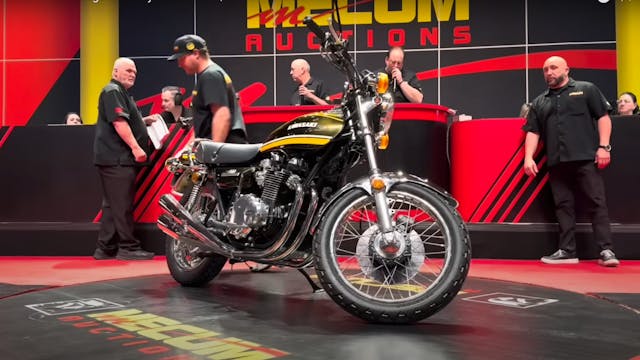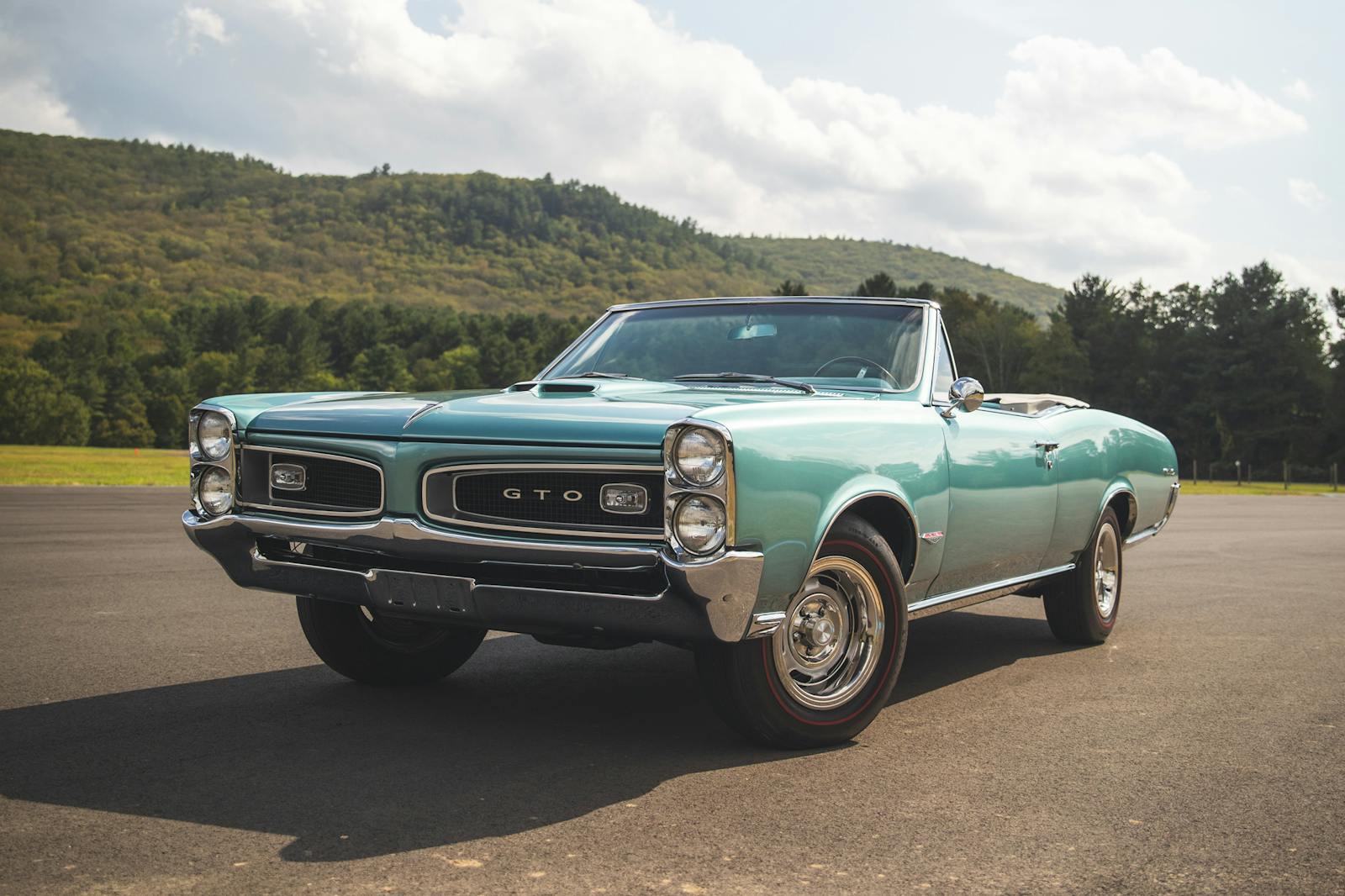Questions Raised, and Answered, About Kawasaki Sold at Mecum Auction
Immediately following its blockbuster Kissimmee, Florida event (now the largest collector car auction in the world), Mecum Auctions held its 33rd Annual Vintage and Antique Motorcycle Auction at the South Point Hotel and Casino in Las Vegas.
This has become the largest motorcycle auction in the world, with the 2024 event featuring some 2000 motorcycles.
One of them, a 1974 Kawasaki Z2 750RS, was among the auction’s modern-era stars, with a Mecum-estimated price of $75,000 to $95,000. That estimate was spot on, with the Kawasaki selling for a gavel price of $85,000.
Though Mecum is scrupulous about vetting the vehicles it sells, shortly after the Kawasaki was sold, questions were raised about the motorcycle’s authenticity.
But first, why did this bike sell for so much? Because the Z2 was a Japanese-only motorcycle, sort of the little brother for the 900cc Z1 widely sold in America beginning in 1972. Japanese law prohibited bikes with larger than 750cc engines, so Kawasaki built the Z2 for its domestic customers. It went on the market in March of 1973.
According to a 2017 story in Motorcycle Classics magazine, many American military servicemen stationed in Japan during the 1970s bought motorcycles there for fun and for transportation, and some brought their bikes home after their tour of duty ended. A Kawasaki collector quoted in the story suggested that as many as 25 to 50 of the 69-horsepower Kawasaki Z2s made it back to the States. Fewer than that have survived, making the Mecum-sold Z2 a legitimate collector’s item.
But the same day the Z2 sold, questions arose. The story broke with a YouTube video posted by CycleDrag.com, titled “Inauthentic Vintage Motorcycle Sold for $85k at Auction?” The description said, “Following the auction it was discovered that the VIN was ground down and was not legible, something that would drastically impact the value of the motorcycle and its proof of authenticity.”

The video showed the Vehicle Identification Number, or at least where the VIN ought to be, on the left side of the headstock of the Kawasaki. It showed a bumpy black surface, with the only part of the VIN legible being the number 75, which looked as though it might have been struck recently. Mecum listed the full VIN, and the last two numbers were indeed 75. The video’s host, CycleDrag’s Jack Korpela, said the Z2 was “one of the most acclaimed bikes here at Mecum, and now there are some serious questions about it.”
According to YouTube, the CycleDrag channel has 580,000 subscribers. It wasn’t so much the video, which is reasonably balanced, but the 500-plus comments posted about the video that are, by and large, profoundly critical of both Mecum and the seller, identified in a CycleDrag.com story and photos as Marcus Swan.

Said one comment: “This is on Mecum. For the fees they charge, they should be on the hook. They should be validating everything. This isn’t eBay.”
Another: “I can’t believe Mecum didn’t verify the frame/number before the sale.”
Still another: “This is not some backyard auction, how could someone show up with that bike and not think the grinding of the numbers wouldn’t be noticed?”
The same day of the sale, Mecum refunded the $85,000 to the buyer, and shipped the Z2, at Mecum’s expense, back to the seller, who had left the auction following the sale.
We reached out to Director of Mecum Motorcycles Greg Arnold for comment, and it was enlightening. “Unfortunately,” he said, “we’re not happy having the story out there that we sold a motorcycle with the VIN ground off. It’s just not true.”
The explanation: “The frame had been powder-coated and that had obscured the frame VIN,” Arnold told Hagerty Insider. “So we asked the seller, before the auction, to remove the powder coating either by grinding or sanding to expose the frame number. He did that at our request and sent us a photograph of it. It’s not great, because of the process he had to go through to get the powder coat off. But there is a frame VIN. So we looked at it and decided that it was passable, and we ran it in the auction.

“We have the photograph of the bare-metal frame VIN, and it corresponds to what the title was. After he did that, he spray-painted over it again, so it wasn’t bare metal. The pictures we see on YouTube, he just painted over the numbers again. Which is certainly understandable.
“Now, after the sale, the buyer had a representative there, someone who I know from past dealings, and he had been alerted by CycleDrag, though certainly he would have questioned it himself. He said, ‘I’m not sure I like this.’ And we said, ‘You know, we’re not going to make anybody take this bike, on this basis, so you talk to your boss and if he doesn’t like it, we’ll be happy to unwind the deal. We’ll send it back to the seller.’
“That’s the long and the short of it. The report that the serial number was ground off is not accurate,” Arnold said. “I think the seller was acting in good faith.”

The YouTube video also questions whether or not the engine VIN should have a small ridge in front of it, which the 1974 Z2 in question does, suggesting that the ridge first appeared on 1975 models. “I have a guy who is very deep into Kawasaki history,” added Arnold, “and he said, ‘No, that ridge is OK.'”
“Here’s the thing,” Arnold said. “It’s a 50-year-old bike. As we all know, there were running changes constantly. It would be hard for me to say this motorcycle is inauthentic. I’m not a 1974 Kawasaki expert, I freely admit that. But if the owner can raise the VIN on the frame, I think he’s got a legitimate motorcycle,” which is what the seller says he’ll do in the CycleDrag.com story.
The bike, Arnold said, should be a “featured piece in someone’s collection.”
***
Check out the Hagerty Media homepage so you don’t miss a single story, or better yet, bookmark it. To get our best stories delivered right to your inbox, subscribe to our newsletters.



So now rich guys are going to ruin the bike world like they’ve done to muscle cars. This is why I’m starting to lose interest in all of it.
Medium claims to have a picture of the “PASSABLE” VIN. If so post it, and ALL of this goes away. Until then, it’s ground off and therefore a fake. If there is proof that we are all wrong, they would have shown it by now!!
Indeed. The pictures of the VIN as it is now have been posted, let’s see the evidence that was presented to Mecum before the auction. Even if all the paperwork checks out, the VIN in the frame is the only item that is of concern.
Mecum ^^^^^. Spell check tried to help me again!!!
I believe that the seller has been terribly mistreated both personally and financially in Mecum’s cancelling of this sale. The article above clearly states that the seller did what they asked regarding the removal of the powder coating so the VIN could be seen. Furthermore they totally exonerate the seller regarding his truthfulness and validity of the VIN number. This problem was made by Mecum and should be solved by Mecum. The gavel went down, the sale should be consummated and the seller paid! Mecum your reputation is at stake here.
No, they brought a suspicious VIN to the attention of people that needed to know. They did nothing wrong. The guy who knowingly hid the VIN is the culprit. If he can prove the VIN to be legit, it’s all over.
Mecum had a chance to put the kibosh to the sale up front; pre-sale questions were obvious and they decided to sail it through. Not a good look.
This is one of the problems of over restoring rare vintage vehicles. The frame should never have been powder coated in the first place. It should have been painted just like it came from the factory. Then this kerfuffle would never have happened. Also looked like the tank had thick clear coat, again not factory. If I were paying 85K for a restored bike I would want it as close to factory as humanly possible.
Jeremiah, I have a 1973 HD XLCH that will stand toe-to-toe with the best classic and historical motorcycles out there. This is the first motorcycle produced at the HD York, PA plant on 02/02/1773, the day of first production at this plant. Yes I said a “0” VIN number which is unheard of. AND, it is likely the only privately owned “0” VIN number motorcycle in existence. You talk about rare, this is it. VIN # 4A6000H3. I have a letter of authenticity from HD. I urge you to read the review in Thunder Press, December 2011. It could go to auction as I am getting older and losing interest .
I have rebuilt alot of 1970’s bikes and a grinder job on the vin spells something is being hidden for a reason. Without the vin and matching title it isn’t adding up. I’ll just about bet it is an old 650 four cylinder frame if I were guessing. They ground it off for a real cover up. But I am not a Kawasaki vintage expert. Other scenario is that the frame was wrecked and bent up so someone hacked out the bends and replaced those sections with pieces from a donor frame that was a close match. Guys with their modern computer guided tools can make anything nowadays. Especially if it brings $85,000 for their work.
I can see why there are questions. Certainly there could have been a better way to have done this paint job around the VIN.
Un f’in Believable………..Questions Raised, Answers Nada
It astounds me that this kind of hackery can happen at that level. Isn’t the first commandment at every auction something like “Thou shall not arrive with thine serial number not precisely matching the number indicated on thine title”?
So Mecum and now apparently Hagerty must think people are idiots. There’s no bringing that VIN number back
Actually if the area is polished and etched with nitric acid, the molecular structure in that area will still reveal the numbers. But then it will need to be re-stamped as the number will only be visible in the structure of the metal, not in the surface. If any numbers have been stamped over the top, the structure will be a mess underneath and no numbers will be revealed at all…
Which leads to the question ,if the s/n is ground ,worn of “incorrectly” stamped . Even with documentation you can’t restamp a vin . In Canada we can apply re vin and will be supplied with a different vehicle serial number . To me the bikes never able to be what it’s said to be , yet in the car world pop rivet the plate on the firewall and alls good!
An interesting example of how reporters and social media screw things up. It can certainly be argued that the VIN should’ve been more visible after powder coating and after its subsequent revealing and then re-painting. But the CycleDrag.com article was typical, in that it presented one possible side of things without asking for clarification. Then, as usually happens, people jump on the band wagon, attacking Mecum, the seller of the bike, etc. This is how too many of us form opinions and beliefs in life. And by the way, thank you, everyone, for calling the identification the VIN, as opposed to the “VIN number”, which drives me nuts and is like calling an ATM an “ATM machine”.